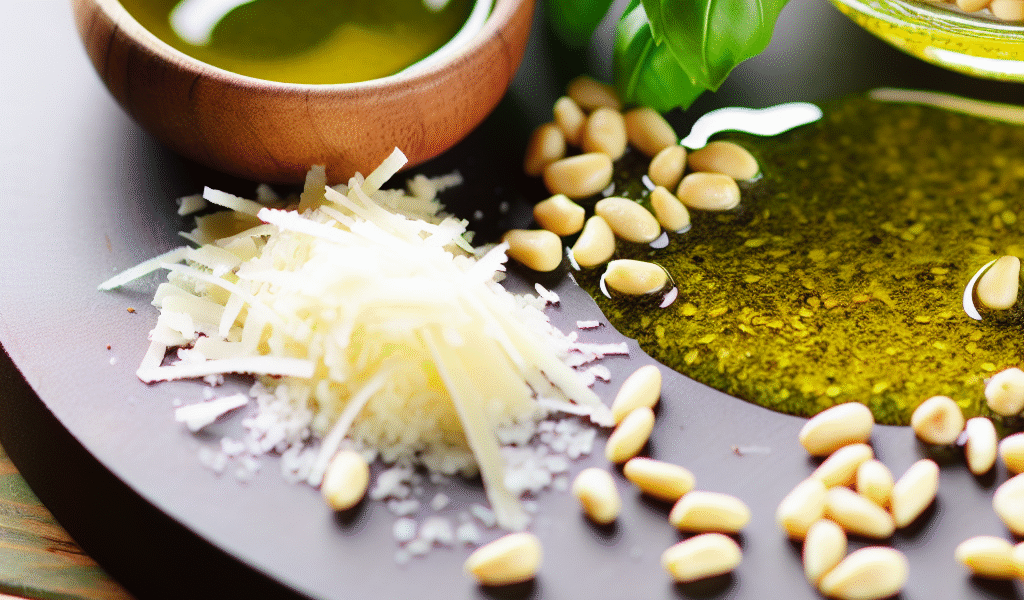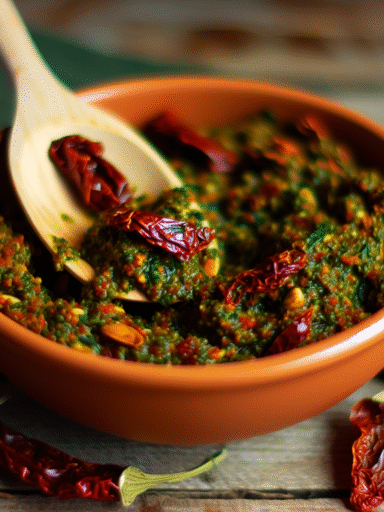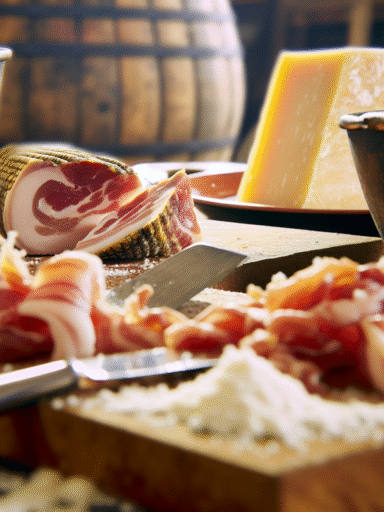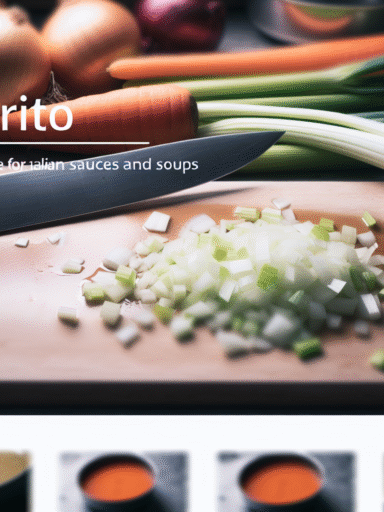Pesto Sauce
Tags / Categories: Herbaceous, Nutty, Fresh, Basil, Pine Nuts, Parmesan, Italian, Ligurian Cuisine, Pasta Sauce, Dip, Marinade
Quick Info Box
- Prep Time: 10 minutes
- Cook Time: 0 minutes
- Total Time: 10 minutes
- Difficulty Level: Easy
- Yield: About 1 cup (240 ml) of pesto sauce
Ingredients List
- 2 cups fresh basil leaves, packed
- 1/2 cup extra virgin olive oil
- 1/3 cup pine nuts
- 2-3 cloves garlic, peeled
- 1/2 cup freshly grated Parmesan cheese
- Salt, to taste
- Freshly ground black pepper, to taste
- Optional: 1 tablespoon lemon juice (to brighten flavor)
How to Make Classic Pesto Sauce
Understanding the Ingredients and Their Roles
Pesto is a vibrant, herb-infused sauce traditionally made from fresh basil leaves, pine nuts, olive oil, garlic, and Parmesan cheese. Each ingredient contributes uniquely — basil provides a fresh, aromatic base, pine nuts add buttery texture, garlic offers a pungent depth, and Parmesan lends a salty, umami richness. Olive oil binds these components into a luscious, creamy consistency.
Step-by-Step Preparation
- Toast the Pine Nuts: Lightly toast pine nuts in a dry skillet over medium heat, stirring constantly, until golden and fragrant (about 3-4 minutes). This enhances their nutty flavor and adds complexity.
- Combine Basil and Garlic: In a food processor or blender, pulse the fresh basil leaves and garlic cloves until finely chopped.
- Add Pine Nuts and Cheese: Add the toasted pine nuts and freshly grated Parmesan to the processor and pulse a few times to combine.
- Drizzle in Olive Oil: With the processor running on low, slowly pour in the olive oil until the mixture becomes smooth but still slightly textured.
- Season: Taste and season with salt and freshly ground black pepper. Add lemon juice if desired to brighten the flavors.
- Adjust Consistency: If the pesto is too thick, add a little more olive oil or a splash of warm water until your preferred consistency is reached.
Serving Suggestions & Culinary Uses
- Classic Use: Toss pesto with freshly cooked pasta such as trofie, linguine, or fettuccine for an iconic Ligurian dish.
- Spread & Dip: Use as a spread on sandwiches, bruschetta, or crostini to add a fresh herbal punch.
- Marinade & Drizzle: Brush onto grilled vegetables, chicken, or fish for enhanced flavor.
- Salad Dressing: Thin pesto with a bit of lemon juice or vinegar and olive oil to create a vibrant salad dressing or sauce.
Origin & History of Pesto
Pesto hails from the Liguria region of northwest Italy, particularly the coastal city of Genoa. The name “pesto” derives from the Italian verb “pestare”, meaning “to pound” or “crush,” referencing its origins as a sauce made by grinding ingredients in a mortar and pestle. Dating back to Roman times, pesto evolved from ancient herb pastes, with basil and pine nuts eventually becoming staples due to local agricultural abundance. Traditionally, the sauce was prepared fresh daily and served with regional pasta varieties. Its global popularity today attests to its simple yet unforgettable flavor.
Variations & Substitutions for Pesto Sauce
While classic pesto is basil-centric, there are many delicious adaptations and alternatives to suit different tastes and dietary needs:
- Nuts: Swap pine nuts with walnuts, almonds, or cashews for variation in texture and flavor. Toast nuts lightly for best results.
- Greens: Substitute basil with arugula, spinach, kale, or parsley to create herbaceous or peppery twists.
- Cheese-Free: Replace Parmesan with nutritional yeast or omit it entirely for a vegan-friendly pesto.
- Garlic Level: Adjust garlic quantity to preference or roast whole garlic cloves for a milder, sweeter taste.
- Oil: While extra virgin olive oil is traditional, avocado oil or nut oils can offer different flavor profiles.
Storage & Make-Ahead Tips
Pesto can be made in advance and stored with care to preserve its vibrant green color and fresh flavor:
- Refrigeration: Store pesto in an airtight container for up to 5 days. To prevent oxidation and browning, pour a thin layer of olive oil over the surface before sealing.
- Freezing: For longer storage, freeze pesto in ice cube trays, then transfer cubes to a freezer bag for up to 3 months. Thaw in the fridge before use.
- Reheating: Pesto is generally served at room temperature or chilled; avoid heating to maintain flavor and texture. If mixing with hot pasta, heat pasta first then stir in pesto off-heat.
Nutritional Information (per 2-tablespoon serving)
- Calories: Approximately 160 kcal
- Fat: 16 g (mostly healthy monounsaturated fats)
- Carbohydrates: 1.5 g
- Protein: 2.5 g
- Fiber: 0.5 g
- Sodium: Varies based on added salt and cheese
Related Sauces / Try Next
- Salsa Verde – An Italian green sauce with herbs, capers, and anchovies.
- Romano Pepper Sauce – A spicy sauce using roasted peppers and garlic.
- Sun-dried Tomato Pesto (Pesto Rosso) – A delicious twist using sun-dried tomatoes and nuts.
FAQ
Q: Can I use a mortar and pestle instead of a blender?
A: Absolutely! Using a mortar and pestle is the traditional method and gives pesto a slightly different texture and flavor due to the manual grinding process. It requires patience but enhances the authenticity of the sauce.
Q: What if I can’t find fresh basil?
A: Fresh basil is key to classic pesto’s bright flavor. However, you can substitute with other fresh herbs like spinach or arugula to maintain freshness. Avoid dried basil as it won’t provide the same aromatic quality.
Q: How can I prevent pesto from turning brown?
A: To reduce oxidation, store pesto in an airtight container with a thin layer of olive oil on top, keep refrigerated, and minimize air exposure. Using lemon juice also helps preserve its vibrant green color.
Conclusion
Pesto sauce is a quintessential example of Italian simplicity and flavor — fresh basil, nuts, cheese, and olive oil combined into a vibrant, versatile condiment. Its quick preparation, versatility in dishes, and rich cultural background make it a beloved staple worldwide. Whether tossed with pasta, spread on bread, or used as a marinade, mastering pesto opens endless culinary possibilities to enhance everyday meals with a touch of Ligurian magic.



